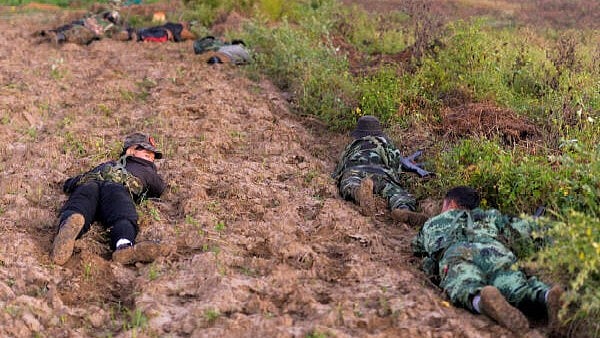
File photo: People's Liberation Army forces fight the Myanmar junta army near Sagaing Region in Myanmar in November 2023.
Reuters
For the anti-junta resistance in Myanmar, the final month of 2024, building on last year’s ‘Operation 1027’ offensive of the Three Brotherhood Alliance (3BHA), has been eventful and remarkable. In the north, the Myanmar National Democratic Alliance Army (MNDAA), a powerful ethnic armed organisation (EAO) that had turned the tide in the armed struggle against the junta as part of the 3BHA, buckled under Chinese pressure and announced a ceasefire, days after the allied Ta’ang National Liberation Army (TNLA) said it was ready to talk peace.
Further south, along Myanmar’s western edges bordering India, a different and much more spectacular story has unfolded in the past two weeks.
On 20 December, the Arakan Army (AA) – a powerful Rakhine Buddhist EAO – captured the Myanmar military’s Western Command headquarters in Ann. This is the second regional military command headquarters that the junta has lost to the resistance after the MNDAA seized its Northeastern Command headquarters in northern Shan State’s Lashio in August. The AA now claims to control 14 out of Rakhine State’s 17 townships, including all of its north. It also controls the entirety of the Myanmar-Bangladesh land border and Paletwa Township in southern Chin State.
A day after Ann’s fall, the Chin Brotherhood Alliance (CBA), a coalition of five Chin armed groups supported by the AA, captured Mindat town in southern Chin State following days of fierce fighting. Soon after, it seized junta outposts in Kanpetlet, abutting the hills south of Mindat. It has also taken over most government buildings in Falam, north of the Chin capital of Hakha, and is advancing toward the junta’s infantry base in the town. According to the CBA, Chin resistance forces, which also include a parallel armed coalition led by the powerful Chin National Front (CNF), now control 80-85% of Chin State. Further north, both the Kachin Independence Army (KIA) and People’s Defence Forces (PDFs) in Sagaing Region, which extends to Tamu on the India-Myanmar border opposite Moreh, have made significant gains against junta forces.
These dramatic developments underline a stark reality for New Delhi – the junta is rapidly losing western Myanmar and, in turn, control over large parts of the country’s 1,640 km land border with India. This region has become a heartland of the nationwide anti-junta war, transforming into a geography of liberation and hope. With the AA firmly controlling the Myanmar-Bangladesh border and parts of an international coastline with offshore hydrocarbon assets, these shifts in strategic control also carry major economic implications.
For India, the geoeconomic consequences of anti-junta forces capturing nearly all of western Myanmar are significant in three ways.
Western Myanmar is a natural gateway to the country’s economic and political heartland, dominated by the Bamars. It is critical to overland linkages to central and eastern Myanmar and, by extension, Southeast Asia and China’s Yunnan province. The fall of Ann and southern Chin towns like Mindat foreshadows growing resistance control over hinterlands east of the Arakan Yoma mountains. These areas form a crucial buffer zone between the ethnic peripheries and the Bamar heartland. The AA is also expanding its influence into Magway and Ayeyarwaddy regions, making it increasingly difficult for the junta to project power westward.
Western Myanmar provides an overland route to the Indian Ocean, serving as an economic springboard for landlocked Northeast India. This strategic value is exemplified by the Kaladan Multi-Modal Transit and Transport Project (KMMTTP), which aims to connect Northeast India to the Bay of Bengal via western Myanmar, with Sittwe as the central node. With India losing access to Chittagong Port after the fall of the Sheikh Hasina government in Bangladesh, completing the KMMTTP is even more critical.
Western Myanmar’s proximity to the Bay of Bengal and Indian Ocean makes it geopolitically indispensable. China’s presence in Rakhine State, particularly through the Kyaukpyu deep-sea port, underscores this importance. The AA, which controls parts of Ramree Island and meets regularly with Chinese officials, wields significant leverage. Resistance control over the KMMTTP route further complicates India’s position.
These realities compel New Delhi to recalibrate its Myanmar strategy. It can no longer rely on the junta to protect its interests and must proactively engage with resistance forces. The AA, less vulnerable to Chinese coercion than its northern allies, is particularly crucial. Meanwhile, the KIA, Sagaing forces and Chin resistance groups have shown resilience and autonomy, making them potential partners in countering Beijing’s growing influence.
New Delhi must also navigate the ethnic and religious complexities of the region, spanning Rakhine, Chin and Manipur, as well as neighbouring Bangladesh. This volatile mix of majoritarianism, ethnic rivalries and competing national interests could destabilise Northeast India. To address this, India must play a constructive role in mediating conflicts and promoting regional stability.
Finally, India must shift its focus from supporting a centralised Myanmar governed from Nay Pyi Taw to fostering a more federal polity that respects ethnic aspirations. This approach aligns with India’s federal experience and positions it as a constructive player in Myanmar’s transition from military dictatorship to a democratic union.
The recent Thai initiative to explore regional solutions to Myanmar’s crisis, along with Malaysia’s upcoming ASEAN chairmanship, presents an opportunity for India to lead in stabilising its troubled neighbourhood.
(Gautam Mukhopadhaya is a Senior Visiting Fellow at the Centre for Policy Research, New Delhi, and former Indian ambassador to Syria, Afghanistan and Myanmar. Angshuman Choudhury is a joint doctoral candidate in Comparative Asian Studies at the National University of Singapore and King’s College London)